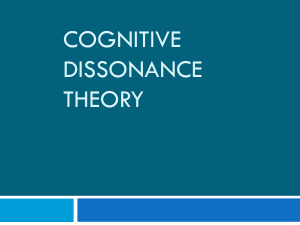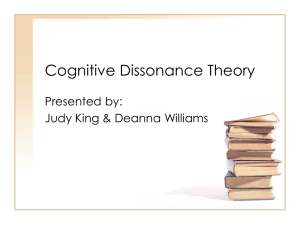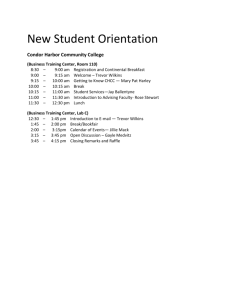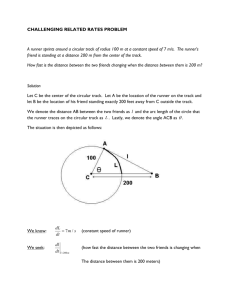I can still remember every detail of that sunny spring day almost five
advertisement
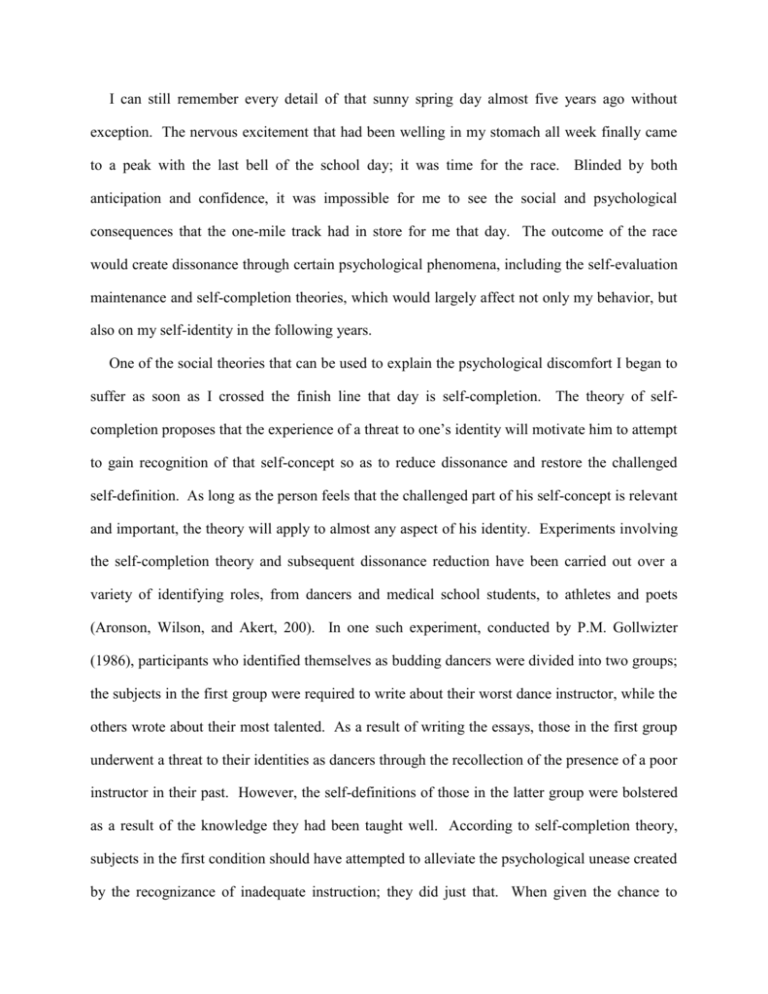
I can still remember every detail of that sunny spring day almost five years ago without exception. The nervous excitement that had been welling in my stomach all week finally came to a peak with the last bell of the school day; it was time for the race. Blinded by both anticipation and confidence, it was impossible for me to see the social and psychological consequences that the one-mile track had in store for me that day. The outcome of the race would create dissonance through certain psychological phenomena, including the self-evaluation maintenance and self-completion theories, which would largely affect not only my behavior, but also on my self-identity in the following years. One of the social theories that can be used to explain the psychological discomfort I began to suffer as soon as I crossed the finish line that day is self-completion. The theory of selfcompletion proposes that the experience of a threat to one’s identity will motivate him to attempt to gain recognition of that self-concept so as to reduce dissonance and restore the challenged self-definition. As long as the person feels that the challenged part of his self-concept is relevant and important, the theory will apply to almost any aspect of his identity. Experiments involving the self-completion theory and subsequent dissonance reduction have been carried out over a variety of identifying roles, from dancers and medical school students, to athletes and poets (Aronson, Wilson, and Akert, 200). In one such experiment, conducted by P.M. Gollwizter (1986), participants who identified themselves as budding dancers were divided into two groups; the subjects in the first group were required to write about their worst dance instructor, while the others wrote about their most talented. As a result of writing the essays, those in the first group underwent a threat to their identities as dancers through the recollection of the presence of a poor instructor in their past. However, the self-definitions of those in the latter group were bolstered as a result of the knowledge they had been taught well. According to self-completion theory, subjects in the first condition should have attempted to alleviate the psychological unease created by the recognizance of inadequate instruction; they did just that. When given the chance to participate in a dance concert following the experiment, they chose to perform in public almost two weeks earlier than those whose self-concepts had not been threatened. After their status as up-and-coming dancers had been called into question, the participants were eager to prove in front an audience that they had a genuine claim to the identity of dancer (Aronson et al., 201). Another psychological principle that pertains to my actions in the wake of that race is the selfevaluation maintenance theory, formulated by Abraham Tesser (1988). The idea behind selfevaluation maintenance is similar to that of self-completion; however, in maintenance theory the threat to one’s identity comes directly from another individual’s superior skill in the self-defining behavior. The severity of the challenge to one’s identity depends not only on the closeness of the individual who poses the threat, but also on the personal importance of the identity that comes under fire. (Aronson et al., 201-2). The dissonance aroused at the hands of the other individual is the same as that under the self-completion theory in that it is a very uncomfortable state, but the methods used to ameliorate this discomfort under the self-evaluation maintenance theory differ. Rather than strive for social recognition of the threatened self-identifying concept, one who attempts to reduce dissonance under maintenance theory will either distance himself from the one who has threatened his concept, convince himself that the identifying trait is no longer as important as it once was, or through practice, sharpen his skill in the self-defining activity. Different experiments involving the self-maintenance theory have been conducted in order to examine each of the three dissonance reducing behaviors. In 1981, Tesser conducted a study that placed two college students, one a confederate of Tesser, in competition with each other on a general knowledge quiz. The questions in one condition were purposely written in order to correspond with subject matter relating to the participant’s self-identity, while the questions in the other condition were chosen at random. Subjects in the first condition suffered great psychological unease when they failed to answer as many questions as the confederate, who had been given the answers before the quiz began. As expected, people in this condition distanced themselves further from the accomplice than did those in the other condition; they did not want to remain with someone who had outshined them in an area central to their identities (Aronson et al., 202). It never occurred to me that I would not win the race held behind Wilmette Junior High School that day. I wasn’t cocky about it; I had simply never been challenged in a race before, and was always known as the fastest runner in school. With a father who has participated in the Boston Marathon, a brother who runs college track and cross country, and a mother who competes in triathlons on a regular basis, running has always come naturally to me. However, I had also never encountered Trevor Hitch. Shortly after the sharp crack of the starting gun, I knew that this would be the first race from which I would not be taking home a blue ribbon. He was already way in front of the pack and I was struggling just to keep from falling further behind. His lung-burning pace and the nagging thought that this was the first race in which I had seen another runner’s back, were just too much for me. When I finally got to the line, the tape had already been broken, and I, for the first time in my thirteen years, had finished in second place. To say that I was shocked would be a vast understatement. Even as my friends proceeded to congratulate me on my strong finish I knew that they, too, were surprised at the event they had just witnessed. As I was finishing that inter-junior high race, the dissonance that I would experience over the next months was just beginning. In the ensuing weeks of school I eagerly awaited every gym class with the hope that we would be running the mile; I desperately wanted to regain my reputation as the fastest. Thankfully, I was able to do just that by again defeating all competitors in the remainder of my junior high races. However, just as I was recapturing my former identity, the school year, and junior high came to a close; it was time for high school. Within the first few weeks of attending New Trier High School, I had already made what was to become one of my closest friends in Trevor Hitch. It seemed as though we were almost the same person; he listened to the same music I did, he liked the same movies, read the same books, had the same competitive spirit, and, as luck would have it, excelled at running. Upon discovering our shared talent of running, we decided that we would both join the track team that winter. Then, as I was almost fully adjusted to life in high school, irony reared its ugly head and the psychological unease that I first felt on the day of the race once again appeared in my life. In one of our conversations concerning running, I found out that it had been he who went home with the first-place ribbon that day. Trevor though it was cool that we had crossed paths in the past and not realized it until then; of course it was cool to him, he had won, and I had not. Now whenever I was around him, I had to face the fact that he was a far better runner than I. The theory of self-completion comes into play at the finish line of my red ribbon race. My self-concept as a runner had taken a severe blow, and as a result a large amount of dissonance had been created. I, as did the dancers who had their identities challenged in Gollwitzer’s experiment, began to seek a way to convince others that I was worthy of my former selfdefinition; I was still the best runner. I ran every subsequent race as though my life were on the line, and made sure everyone took notice when I was victorious. I even went so far as to request of my teacher that we do the mile run every day in class rather than the much more popular alternatives of basketball and softball. I was willing to do whatever was necessary to regain my status, and with time I eventually did, if only for a short while. The discovery that my close friend Trevor was in fact the one who had beaten me that day brings the self-evaluation maintenance theory into my story. Like those who had been outsmarted in their fields of expertise in Tesser’s experiment, I again felt the need to reduce the dissonance aroused by Trevor’s superior talent. However, because I had become such good friends with him, the dissonance reduction method of separation used by Tesser’s subjects was not a feasible option for me. Also, coming from an environment so enthusiastic towards running, I could not simply distance myself from the sport. Thus, I was left with only one option in order put my mind back at ease; I could train and once again gain the upper hand. Just as I had recaptured my identity of the top runner in junior high, through hard work and determination I planned on doing the same in high school. However, despite months of practice, my plans never materialized, and, although I performed very well in my first season, I was certainly not the best, and I was never able to defeat Trevor. Yet, as time went on, both the knowledge that I had performed at my best and also that I had gained a close friend and training partner worked to dissemble my built up dissonance. High school was a much larger and competitive atmosphere, and I understood this. My self-concept of being the best runner that I had held for so long gradually gave way to an identity as solid runner who performed well at meets. The dissonance that I underwent during the transition from eighth grade to high school can be explained both in terms of the self-completion and self-evaluation maintenance theories. My second place finish brought into question the validity of my claim to fastest runner for the first time in my life, and, as outlined under completion theory, aroused great psychological unease. Only by continually proving that I was indeed the fastest in front of my classmates following that race could I eventually solidify my former identity as the best runner and put my mind at ease. Self-evaluation maintenance theory provides a perfect explanation of the reappearance of my psychological arousal in high school; the discovery that my good friend Trevor was the one who had defeated me that day posed a significant threat to my newly recaptured self-concept. However, maintenance theory fails to include the primary method of dissonance reduction that I employed in my freshman year—altering my self-concept. Since ending my friendship with Trevor and giving up running were both undesirable methods of alleviation, and once again becoming the fastest was not possible, perhaps maintenance theory should not so narrowly define its possible means of dissonance reduction. Works Cited Aronson, E., Wilson, T., and Akert, R. (2001). Social Psychology: Fourth Edition. New Jersey: Prentice Hall.

